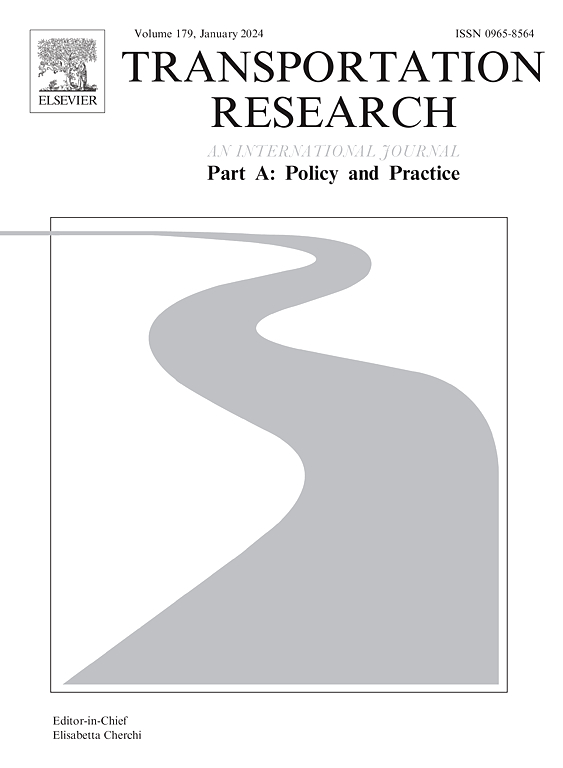Does perceived accessibility affect travel behavior or vice versa? Alternative theories testing bidirectional effects and (in)consistency over time
IF 6.3
1区 工程技术
Q1 ECONOMICS
Transportation Research Part A-Policy and Practice
Pub Date : 2024-11-12
DOI:10.1016/j.tra.2024.104318
引用次数: 0
Abstract
In theory, the unidirectional relationship between perception and behavior has been well established. In this line, the relationship between perceived accessibility and travel behavior has also gained traction in the transport domain. There is, however, less knowledge regarding the dynamic of bidirectional effects between these two variables and (in)consistency over time. Employing the Netherlands Mobility Panel data, we investigate the direction of the (causal) effect between perceived accessibility and travel behavior/travel preference. Using a two-wave cross-lagged panel model, we test how this theory works among urban travelers (n = 4,946). The findings show that the relationship between perceived accessibility and travel-related decisions varies depending on the transport mode and whether it is about travel behavior or preference. The effects might show bidirectionality, unidirectionality, or neither. Findings highlight that the perception-behavior theory is primarily consistent with revealed travel behavior as opposed to stated preferences. We find a bidirectional perception-(travel) behavior relationship. Unlike conventional wisdom and commonly used theoretical links, we find that travel mode use has a larger impact on perceived mode-specific accessibility than the reverse effect (the more expected link). Travel behavior also shows consistently lower levels of perception-behavior dissonance than preferences do. The study finds that perception consistently influences public transport use and preferences, unlike for cars and bicycles. Policy-wise, this implies that efforts aimed at correcting misperceptions about the accessibility of public transport could still have a positive impact on individuals’ decisions to choose public transport.
感知到的可及性是否会影响旅行行为,反之亦然?检验双向效应和(不)随时间变化的一致性的替代理论
从理论上讲,感知与行为之间的单向关系已经得到了很好的证实。因此,在交通领域,交通可达性感知与出行行为之间的关系也越来越受到重视。然而,人们对这两个变量之间的双向效应动态以及随时间变化的(不)一致性了解较少。利用荷兰交通面板数据,我们研究了感知可达性与旅行行为/旅行偏好之间的(因果)效应方向。通过两波交叉滞后面板模型,我们检验了这一理论在城市旅行者(n = 4946)中的作用。研究结果表明,交通便利感与旅行相关决策之间的关系因交通方式而异,也因旅行行为或偏好而异。其影响可能是双向的,也可能是单向的,或者两者都不是。研究结果突出表明,感知-行为理论主要与显性旅行行为相一致,而非显性偏好。我们发现感知与(旅行)行为之间存在双向关系。与传统观点和常用的理论联系不同,我们发现旅行模式的使用对感知到的特定模式可达性的影响大于反向影响(更符合预期的联系)。与偏好相比,旅行行为也始终显示出较低的感知-行为失调水平。研究发现,与汽车和自行车不同,人们的认知会持续影响公共交通的使用和偏好。从政策角度看,这意味着旨在纠正人们对公共交通可达性的错误认识的努力仍会对个人选择公共交通的决定产生积极影响。
本文章由计算机程序翻译,如有差异,请以英文原文为准。
求助全文
约1分钟内获得全文
求助全文
来源期刊
CiteScore
13.20
自引率
7.80%
发文量
257
审稿时长
9.8 months
期刊介绍:
Transportation Research: Part A contains papers of general interest in all passenger and freight transportation modes: policy analysis, formulation and evaluation; planning; interaction with the political, socioeconomic and physical environment; design, management and evaluation of transportation systems. Topics are approached from any discipline or perspective: economics, engineering, sociology, psychology, etc. Case studies, survey and expository papers are included, as are articles which contribute to unification of the field, or to an understanding of the comparative aspects of different systems. Papers which assess the scope for technological innovation within a social or political framework are also published. The journal is international, and places equal emphasis on the problems of industrialized and non-industrialized regions.
Part A''s aims and scope are complementary to Transportation Research Part B: Methodological, Part C: Emerging Technologies and Part D: Transport and Environment. Part E: Logistics and Transportation Review. Part F: Traffic Psychology and Behaviour. The complete set forms the most cohesive and comprehensive reference of current research in transportation science.

 求助内容:
求助内容: 应助结果提醒方式:
应助结果提醒方式:


